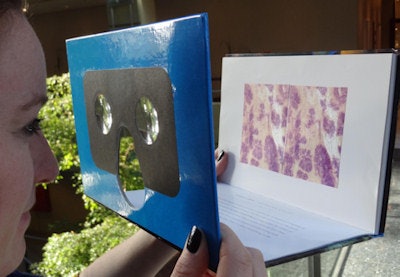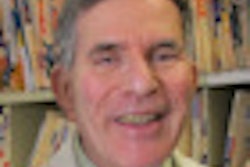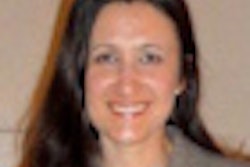
To bridge the gap between clinicians and to educate women directly, Dr. László Tabár of Falun Central Hospital in Sweden and two colleagues have released a breast health book in a novel 3D format.
 Dr. László Tabár.
Dr. László Tabár.
The 64-page book, Understanding the Breast in Health and Disease, includes 3D stereoscopic thick-section histology images that can be viewed with special lenses that are packaged with it. Also available are audio commentaries that help readers understand the book's approach and how to use it, according to Tabár and co-authors Drs. Tibor Tot and Peter B. Dean. Tot also is at Falun Central Hospital, and Dean is at the University of Turku in Finland.
Communication is key
When it comes to breast cancer, there can be disconnect between diagnostic teams (radiologists pathologists) and therapeutic teams (surgeons, medical and radiation oncologists), according to Tabár -- and the large, thick-section 3D histology technique brings the radiologist and pathologist to a common ground for a better understanding of breast morphology.
"Pathologists talk about cells and cellular details," Tabár told AuntMinnie.com via email. "Breast imagers don't see cells on the mammogram, the ultrasound, or the MRI, but we do see the breast structure. The 3D histology technique, with its low resolution, can bridge the gap between the different specialists. This way we can come closer to each other, understand where the malignant or benign cells are originating from and are localized."
The book's stereoscopic pictures are made from a pair of photographs taken from slightly different angles. When the pictures are seen through the special viewer, they reproduce natural 3D vision, according to Tabár. The thick-section pathology technique for the book's images was originally developed by Dr. Sefton Wellings of the University of California, Davis and modified by Tabár's group for the book's purposes.
 When seen through the special viewer, the book's stereoscopic pictures appear in 3D. All images courtesy of Dr. László Tabár.
When seen through the special viewer, the book's stereoscopic pictures appear in 3D. All images courtesy of Dr. László Tabár.Knowledge is power
Mammography screening has changed the way clinicians deal with breast cancer, and it's time to rethink the old-fashioned terminology created long before screening started, according to Tabár.
"How can doctors treat their patients properly when they hardly understand each other?" Tabár told AuntMinnie.com. "For example, the term 'ductal carcinoma in situ' [DCIS] is misleading. There are 12 to 13 different imaging presentations of DCIS, and in 85% of the cases it has nothing to do with the breast's ducts. It's like having 12 very different children and calling them all by the same name."
Not only does the book help radiologists and pathologists get on the same page, it educates women about the breast's basic building structures in its normal state and how these structures change when pathology -- either benign or malignant -- distorts them.
"Our book helps educate women about the true benefit of early detection, so they will visit a breast center that will provide high-quality care for them -- which will result in using less radical treatment methods and better outcomes for the patients," he said.
Why this book, now?
A book like this is decades overdue, according to Tabár.
 Understanding the Breast in Health and Disease includes 3D stereoscopic thick-section histology images and special lenses to view the images.
Understanding the Breast in Health and Disease includes 3D stereoscopic thick-section histology images and special lenses to view the images.
"Both clinicians and women have needed a book like this for 30 years, ever since population-based screening started," he told AuntMinnie.com. "Early detection has brought about a revolution not only in imaging, but also in treatment. But histology hasn't changed at all."
And basic breast structure education can only help in the debate over screening mammography's harms and benefits, Tabár said.
"There is no intelligent 'debate' about the 'harms' of mammography, and, unfortunately, the proven, lifesaving benefit of it has never been mentioned in this 'debate,' " he said. "I have spent decades of my professional life to educate the providers -- now it's time to educate the consumers, that is the women themselves."
The authors want women to know how beautiful this organ is, Tabár said.
"We want to empower them with knowledge -- since knowledge is power!" he said.
Understanding the Breast in Health and Disease is the first in a series Tabár and colleagues expect to publish; their second work will focus on the prostate gland, Tabár said.
To get more details about the book and how to order it, click here.




















